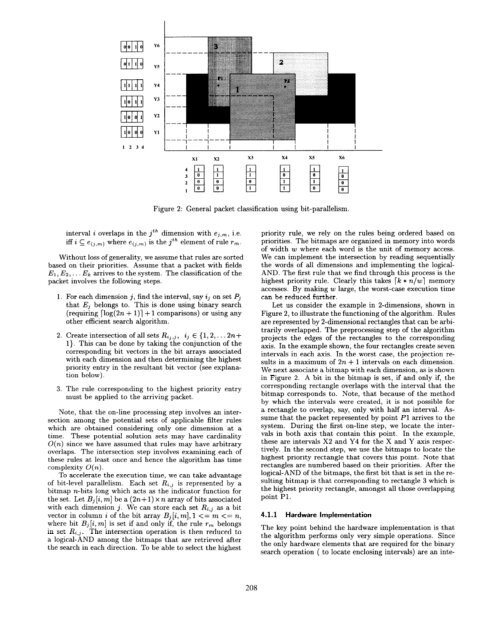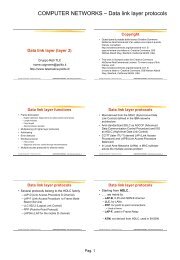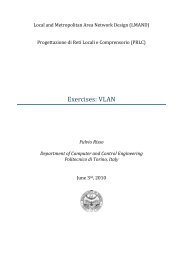High-Speed Policy-based Packet Forwarding Using Efficient Multi ...
High-Speed Policy-based Packet Forwarding Using Efficient Multi ...
High-Speed Policy-based Packet Forwarding Using Efficient Multi ...
Create successful ePaper yourself
Turn your PDF publications into a flip-book with our unique Google optimized e-Paper software.
Figure 2: General packet classification<br />
using bit-parallelism.<br />
interval i overlaps in the jth dimension with ej,m, i.e.<br />
iff i C e(,,,) where e(,,,) is the jth element of rule rm.<br />
Without loss of generality, we assume that rules are sorted<br />
<strong>based</strong> on their priorities. Assume that a packet with fields<br />
Ei, Ez, El, arrives to the system. The classification of the<br />
packet involves the following steps.<br />
1. For each dimension j, find the interval, say ij on set I’3<br />
that E3 belongs to. This is done using binary search<br />
(requiring [log(2n + l)] + 1 comparisons) or using any<br />
other efficient search algorithm.<br />
2. Create intersection of all sets Rzj,J, ij E {1,2,. . .2n+<br />
l}” This can be done by taking the conjunction of the<br />
corresponding bit vectors in the bit arrays associated<br />
with each dimension and then determining the highest<br />
priority entry in the resultant bit vector (see explanation<br />
below).<br />
3. The rule corresponding to the highest priority entry<br />
must be applied to the arriving packet.<br />
Note, that the on-line processing step involves an intersection<br />
among the potential sets of applicable filter rules<br />
which are obtained considering only one dimension at a<br />
time. These potential solution sets may have cardinality<br />
O(n) since we have assumed that rules may have arbitrary<br />
overlaps. The intersection step involves examining each of<br />
these rules at least once and hence the algorithm has time<br />
complexity O(n).<br />
To accelerate the execution time, we can take advantage<br />
of bit-level parallelism. Each set R;,, is represented by a<br />
bitmap n-bits long which acts as t,he indicator function for<br />
the set. Let Bj [i, m] be a (2n+l) x n array of bits associated<br />
with each dimension j. We can store each set Ri,j as a bit<br />
vector in column i of the bit array Bj [i, m], 1
















